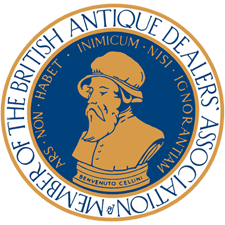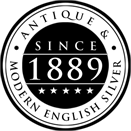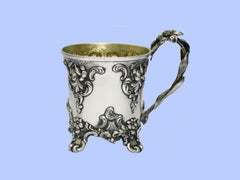It's the finest new silver flatware in the world.
Each piece is individually hand-forged by our highly-skilled craftsmen, here in England.
So here's how to eat like a King:
Firstly, you must choose a pattern. We have a very wide range, ranging from totally plain Early English to the highly decorative Chased and Pierced Vine.
Then you need to let us know how many of which pieces you want in your service. We can pretty much make you any quantities you ask for.
Once everything has been agreed, we then order the silver. It comes specially rolled for us, and this can sometimes take four weeks in preparation.
Here's how we make a spoon.

We start with a thick strip of silver. Our craftsman heats it and as it softens, he hammers it so it begins to form the shape of a spoon. Next it is cooled in water, and then hammered over and over again. Each time the spoon becomes more 'concentrated', and stronger and tougher. This process is what is known as 'hand-forging'. The continuous hammering gives the spoon the weight and strength that you will only see from a hand-forged piece.
Once the shape feels right, the silver is then placed between two lead dies in our Victorian press. The dies are each cut with the design of the appropriate pattern. Once everything is lined up, the press crashes down, with the lead dies making a deep imprint of the pattern on both sides of the spoon. The spoon is then removed, flat, from the press.
Our craftsman then works on the bowl of the spoon to give it the traditional oval shape. He also trims round the edges of the handle to smooth them off. He then gently hammers the handle to insert natural curves where necessary.
The spoon is then sent off, with all the other pieces, to the London Assay Office where it is tested ('assayed') to confirm it is sterling silver, and then stamped with a series of hallmarks (punches). When it comes back to us, the final stage of the process is the polishing. Our polisher can spend up to twenty minutes on a single spoon, smoothing over the rough parts to produce a shiny and flawless finish.
Take a look at some of our most popular patterns. Coburg is rich and dignified, adding a touch of elegance to any table.
Fiddle, Thread & Shell is very traditional, originally based on a variant of a French design.
Hanoverian Engraved is one of our favourites. Our silversmiths make the pieces completely plain. Then we take them to the engraver, who engraves that beautiful pattern around the tops of the handles.
Grecian is a more modern pattern. A product of the Art Deco period of the 1930s, it is based on ancient Greek architecture with a sunken border and cut corners.
Bright Vine is a typical Victorian pattern, filled with grapes and vines. It's fun and simply bursting with energy on the table.
Bright Vine Pattern
And finally, for sheer elegance, take a look at this – it’s our magnificent Chased and Pierced Vine pattern gilded (gold-washed). It looks amazing on the table.

Silver-Gilt Chased and Pierced Vine Pattern
Please email us if you would like to commission a special service from us. Prices vary, but for twelve place settings in most patterns, it will be in the region of around £25,000 (US $40,000).









